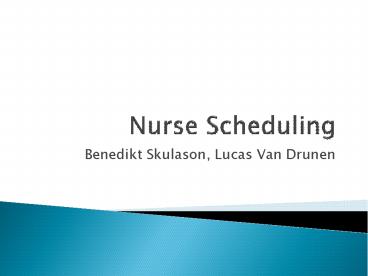Nurse Scheduling - PowerPoint PPT Presentation
Title:
Nurse Scheduling
Description:
A branch of the general staff scheduling problem. However, staffing problems within hospitals are particularly challenging because of the following: – PowerPoint PPT presentation
Number of Views:656
Avg rating:3.0/5.0
Title: Nurse Scheduling
1
Nurse Scheduling
- Benedikt Skulason, Lucas Van Drunen
2
Whats so special about nurse scheduling?
- A branch of the general staff scheduling problem.
- However, staffing problems within hospitals are
particularly challenging because of the
following - Variations in staffing requirements between
different shifts within the day - (e.g. day/evening/night-shift specific
activities) - Variations in staffing requirements between
different days - (e.g. based on schedules from the operating
room, etc.) - The extreme importance of maintaining an
acceptable service level at all times.
3
Two problem stages
- Determine staffing requirement
- Average census
- Average case severity
- Govt and hospital regulations
- Build the schedule
- Assign nurses to shifts subject to constraints
4
We wanted to know
- How to achieve feasible nursing schedules?
- How to maintain schedule feasibility in case of
unexpected events? - Are academic methods of nurse scheduling used in
the real world?
5
Preferential IP method
Preference scheduling for nurses using column
generation Jonathan F. Bard, Hadi W. Purnomo,
2003.
6
Preferential IP method
7
Self-scheduling method
- Blank schedule posted with
- Deadline
- Required staffing level
- Other constraints minimum number of experienced
nurses, etc. - After deadline, manager may need to rework
schedule to achieve required coverage
8
A nurse calls in sick what to do?
Genetic Algorithm for creating schedules similar to a given base schedule
Step 1 Initial individuals (schedules) are generated by a random permutation of each individuals two chromosomes. Chromosome 1 A list of tasks. Chromosome 2 The ordering of nurses associated with the tasks.
Step 2 The current individuals are mated randomly and crossovers and mutations are applied to them, creating offspring.
Step 3 Each individuals fitness is evaluated (feasibility similarity).
Step 4 The fittest individual is moved to the next generation.
Step 5 Remaining individuals for the next generation are chosen by the roulette wheel method, with likelihood proportional to their fitness. Step 6 If a predefined stopping criteria is satisfied, stop, otherwise we go back to step 2.
9
Barriers to implementation
- Many researchers have stated intentions of their
work being implemented - Few models actually make the jump to
implementations - Causes
- Narrow focus
- Customer support
- Proprietary concerns
- Nursing acceptance lack of flexibility,
black-box perception
10
Case study NYU Medical Center
- Staffing requirement from average census,
average care level - Self-scheduling used to build schedule
- Non-unionized nurses
- Role of software
11
Conclusion
- There is a need for scheduling methods that
interface with the real world - The preferential IP method attempts this
- Benefits
- Avoids the black-box syndrome
- Avoids conflicts from exercising seniority or
playing favorites































